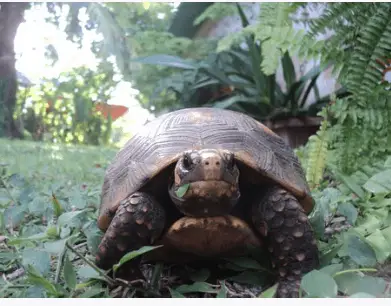
Activity of text interpretation, aimed at students in the sixth year of elementary school, about tortoises. Its legs, rigid and straight, resemble small trunks. Did you know that in Brazil there are only two species of tortoises? Let's meet them? To do this, read the text carefully and then answer the various interpretative questions proposed!
This reading comprehension activity is available for download in an editable Word template, ready to print to PDF, as well as the completed activity.
Download this text interpretation exercise at:
SCHOOL: DATE:
PROF: CLASS:
NAME:
Read:
Tortoises are land animals. Its legs, rigid and straight, resemble small trunks. They are omnivores: they eat fruits, leaves, earthworms, insects and even rats. Only two species are found in national territory: the piranga tortoise (
The piranga tortoise inhabits the Northeast, Midwest, Southeast and South of the country; the tinga tortoise is only found in the Amazon region. The two species reach, on average, 50 centimeters and 18 kilos. The main difference between the tortoise-piranga and the tortoise-tinga is the color of the scales on their feet: while the latter has yellow scales, the former has red scales.
The most famous species of tortoise is only found in the Galapagos Archipelago, a group of 58 islands located in the Pacific Ocean that inspired Charles Darwin to conceive the Theory of the Evolution of Species. The Giant of the Galapagos (Geochelone nigra) can measure up to 1.80 meters and weigh more than 200 kilos. Great, isn't it? But you don't need to run away if you find one! In addition to being extremely slow animals, these tortoises are herbivores: they feed exclusively on fruits, cacti and creeping herbs.
Juliana Rocha. Available in: .

Question 1 - Read what is said about the two species of tortoises found in Brazil, the piranga tortoise and the tinga tortoise:
I. The piranga tortoise has yellow scales.
II. The tinga tortoise has red scales.
III. The piranga tortoise inhabits different regions of Brazil.
What is stated in:
( ) III.
( ) I and II.
( ) I, II and III.
Question 2 - In the passage “Your paws, rigid and straight, resemble small trunks.”, the highlighted adjectives comprise:
( ) a description made by the author.
( ) an opinion defended by the author.
( ) a conclusion reached by the author.
Question 3 - Reread this text fragment:
“The most famous species of tortoise is only found in the Galapagos Archipelago, set of 58 islands located in the Pacific Ocean that inspired Charles Darwin to conceive the Theory […]”
The part highlighted in the fragment above:
( ) evaluates the Galapagos Archipelago.
( ) defines the Galapagos Archipelago.
( ) characterizes the Galapagos Archipelago.
Question 4 – In the prayer “Besides being animals extremely slow […]”, the highlighted term was used for:
( ) explain the meaning of “slow”.
( ) intensify the sense of “slow”.
( ) complement the sense of “slow”.
Question 5 - In the sentence “[…] they feed exclusively of fruits, cactuses and creeping herbs.”, the underlined word could be replaced by:
( ) only.
( ) principally.
( ) randomly.
Question 6 – The author of the text talks directly with the reader in the segment:
( ) "They are omnivores: they eat fruits, leaves, earthworms, insects and even rats."
( ) “The Giant of the Galapagos (Geochelone nigra) can measure up to 1.80 meters […]”
( ) “But you don't need to run away if you find one!”
Question 7 – It can be concluded that the purpose of the text is:
( ) tell a story about tortoises.
( ) publicize a place where there are tortoises.
( ) provide explanations about the tortoises.
By Denyse Lage Fonseca
Graduated in Languages and specialist in distance education.
 report this ad
report this ad
